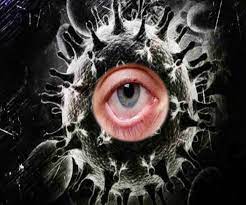Prof BNBM Prasad
King George Medical University
Lucknow: Recent spurt among Covid-19 patients of black fungus infection that is better known as Mucormycosis, has caught the imagination of the public creating panic all around and putting the government on the back foot with advanced cases flooding hospitals and remaining refractory to conventional therapy, adding to the gloom.
Black fungus deriving its name by virtue of colour of its growth is phylogenetically the oldest species of fungus belonging to zygomycetes species that is ubiquitous, growing luxuriously on wet surfaces and organic soil especially in hot and humid conditions.
Air borne fungal elements find nidus in upper respiratory passages especially in sinuses that is rich in mucous offering a matrix and a safe haven for the exuberant growth with loss of local immunity aiding fungal invasion to the surrounding tissue and blood vessels. Entry of fungus in to the system initiates local inflammation, clot formation, decreased blood flow eventually leading to dissemination of the disease with tissue damage and dysfunction. Fungus can gain entry to skin directly through inoculation and to the GIT through contaminated food or water.
Mucormycosis can involve any organ but commonly affects nose, lungs, gut and skin.
It is an opportunistic infection occurring in immune compromised patients, especially diabetics with uncontrolled blood sugar. This disease is sporadic and rare. Before the current Covid- 19 pandemic, estimated incidence of Mucormycosis in India was 14/100,000 population, though much higher than rest of the world with hospital milieu being the major source of the infection. Contaminated linen, dressing material, swabs, medications and hospital equipment’s were considered as attributing factors for the transmission of this eminently preventable hospital/ health care associated infection. Therefore, it is not surprising to find alarming rise in the incidence of Mucormycosis among Covid-19 patients who have flooded our health care system in unmanageable proportions during the second wave of the current Covid-19 pandemic.
During current Covid-19 pandemic, more than 28,000 cases have been reported across India, maximum number of cases from Maharashtra and Gujrat with Uttar Pradesh having incidence far less for the population at risk till now. KGMU Lucknow, the largest hospital in
Uttar Pradesh has seen more than 200 cases, most of them in advanced stage and referred from different hospitals. Interestingly the occurrence of Pulmonary Mucormycosis has been far and few complicating Covid-19 illness, favoring local factors in the nose in the pathogenesis of the Rhino-Occular Cerebral(ROC) Mucormycosis.
Mucor contaminated conduits used for administering oxygen coupled with breach of local defenses due to high flow nasal oxygen therapy and steam inhalations are likely to predispose susceptible ones, especially in diabetics with uncontrolled blood sugar.
Ferritin(iron) and corticosteroids facilitate vascular invasion/entry of fungus into the blood stream from the nose. In severe Covid-19 patients, not only serum ferritin levels are found high but also to combat inflammation/cytokine storm, high doses of corticosteroids have to be used making such cases highly vulnerable for this opportunistic infection.
There were many unsubstantiated reports attributing the use of industrial oxygen and excessive use of corticosteroids for the higher incidence seen among Covid-19 patients.
Some experts believe that contaminated nasal swabs used for RT PCR Covid-19 testing could be a factor which again seems unlikely considering the incidence far less for the number of RT PCR Covid-19 tests done so far across the Nation.
However, all these suspected causative factors need a thorough scientific scrutiny, ensuring safety measures in place to prevent future outbreaks.
Early diagnosis is the key for the better outcome and involves clinical suspicion combined with demonstrating fungus in the specimen such as nasal scrappings, sputum, tissue and blood.
By the time diagnosis is made of the nasal Mucormycosis, the most commonly observed one in the recent outbreak, much tissue damage has occurred involving nose, orbit and brain with high mortality despite surgery and antifungal therapy. Those who survive, many are left with disfigured face, loss of eye sight and neurological deficit forever.
Treatment of Mucormycosis revolves around supportive care, local excision of damaged tissue by surgery and early use of Amphotericin B, the drug of choice. Interestingly this drug is used to treat Kala azar(Leishmaniasis), a condition associated with black pigmentation of the skin, known colloquially as Kala Zwar.
This anti-mucor drug with limited use prior to Covid-19 was in short supply to meet the escalating demand during this pandemic, compelling the central government to import the drug at a very short notice. Unfortunately, this drug needs to be administered daily through intravenous route for a period of 4- 6 weeks to produce the desired result. Further, its use is beset with many complications requiring observation and follow up during the period of the treatment.
To reduce the incidence prevention is the key and it involves implementing stringiest hospital hygiene and sanitation with Hospital Infection Committee and Hospital Engineering Services playing crucial roles for identifying the source and making hospital setting safe.
Sterilization of equipment’s, patient linen, dressing material and swabs etc. and safe hospital practices have to be strictly enforced. Maintaining a very high standard of hygiene and sanitation with emphasis on proper ventilation and temperature and humidity controls is a must.
Identifying the susceptible host, judicious use of steroids, adequate sugar control and avoiding indiscriminate use of antibiotics with personalized approach to the patient care go a long way in making the host least susceptible.
Writer is Lt. Gen (Retd) SM, VSM,
Advisor to UP government (Medical education)
Views expressed are personal





